International HRM and Change: Tesco's Finland Market Entry Report
VerifiedAdded on 2021/02/19
|12
|3159
|62
Report
AI Summary
This report provides a comprehensive analysis of Tesco's international human resource management (IHRM) strategies, specifically focusing on its expansion into the Finnish market. The report examines various performance management strategies, including Key Performance Indicators (KPIs), performance appraisals, 360-degree feedback, management by objectives, and the balanced scorecard. It analyzes the Finnish cultural context using Hofstede's cultural dimensions, assessing power distance, individualism, masculinity, uncertainty avoidance, long-term orientation, and indulgence. The report also explores Tesco's leadership style, recommending a democratic approach. Finally, it offers recommendations for Tesco to enhance employee engagement and navigate the challenges of the new market, emphasizing the importance of team-building activities, risk-taking, and adapting to Finnish cultural nuances.
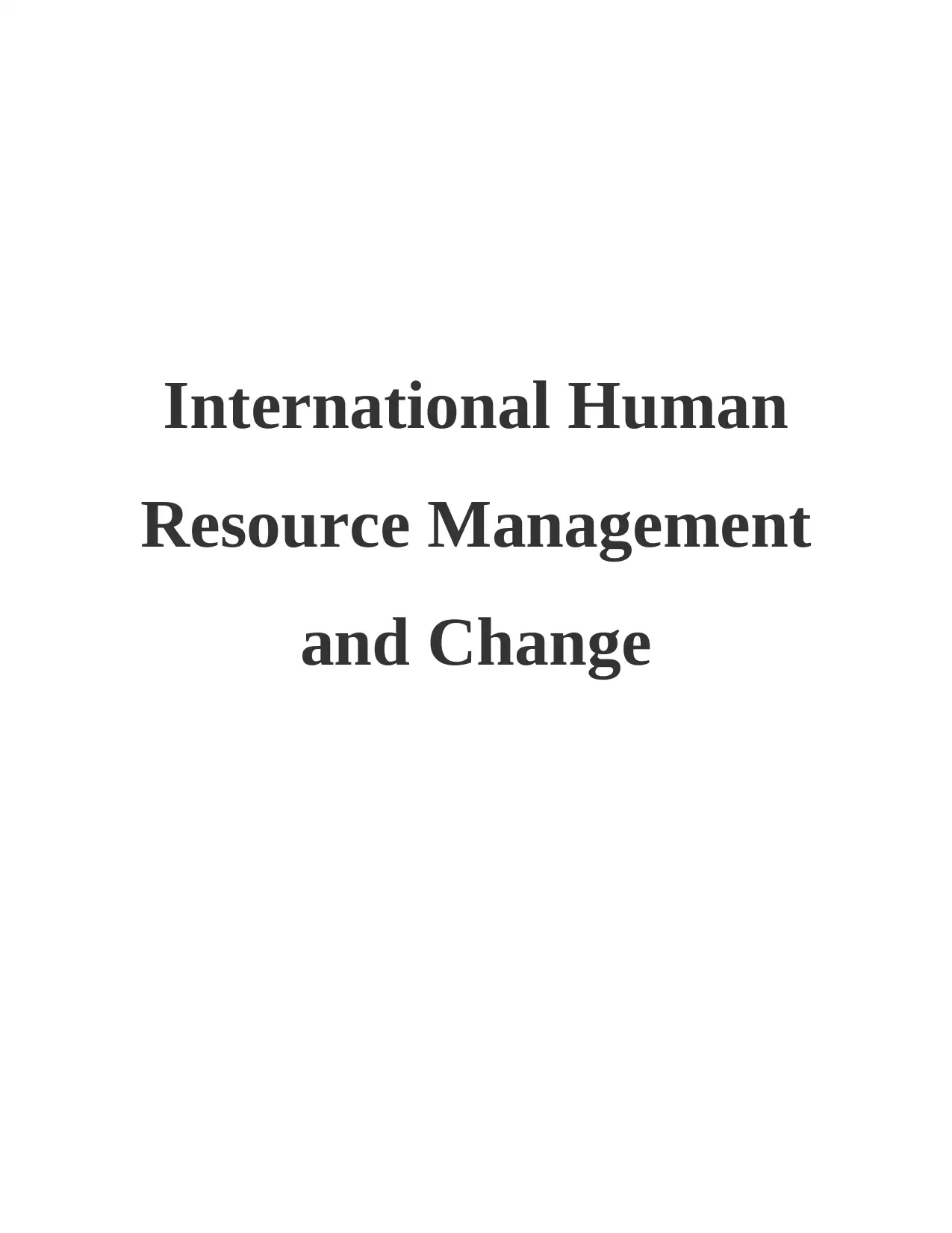
International Human
Resource Management
and Change
Resource Management
and Change
Paraphrase This Document
Need a fresh take? Get an instant paraphrase of this document with our AI Paraphraser
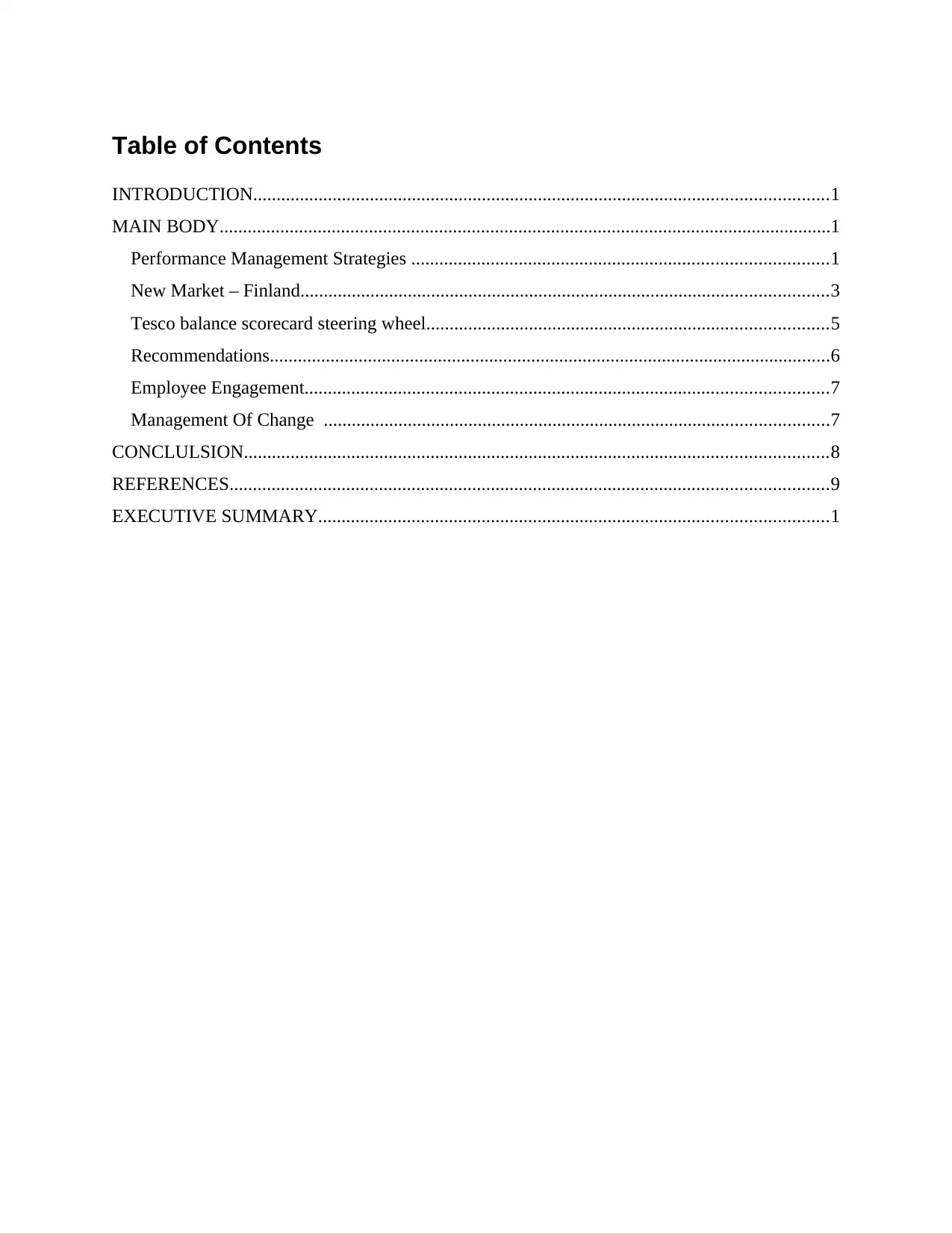
Table of Contents
INTRODUCTION...........................................................................................................................1
MAIN BODY...................................................................................................................................1
Performance Management Strategies .........................................................................................1
New Market – Finland.................................................................................................................3
Tesco balance scorecard steering wheel......................................................................................5
Recommendations........................................................................................................................6
Employee Engagement................................................................................................................7
Management Of Change ............................................................................................................7
CONCLULSION.............................................................................................................................8
REFERENCES................................................................................................................................9
EXECUTIVE SUMMARY.............................................................................................................1
INTRODUCTION...........................................................................................................................1
MAIN BODY...................................................................................................................................1
Performance Management Strategies .........................................................................................1
New Market – Finland.................................................................................................................3
Tesco balance scorecard steering wheel......................................................................................5
Recommendations........................................................................................................................6
Employee Engagement................................................................................................................7
Management Of Change ............................................................................................................7
CONCLULSION.............................................................................................................................8
REFERENCES................................................................................................................................9
EXECUTIVE SUMMARY.............................................................................................................1
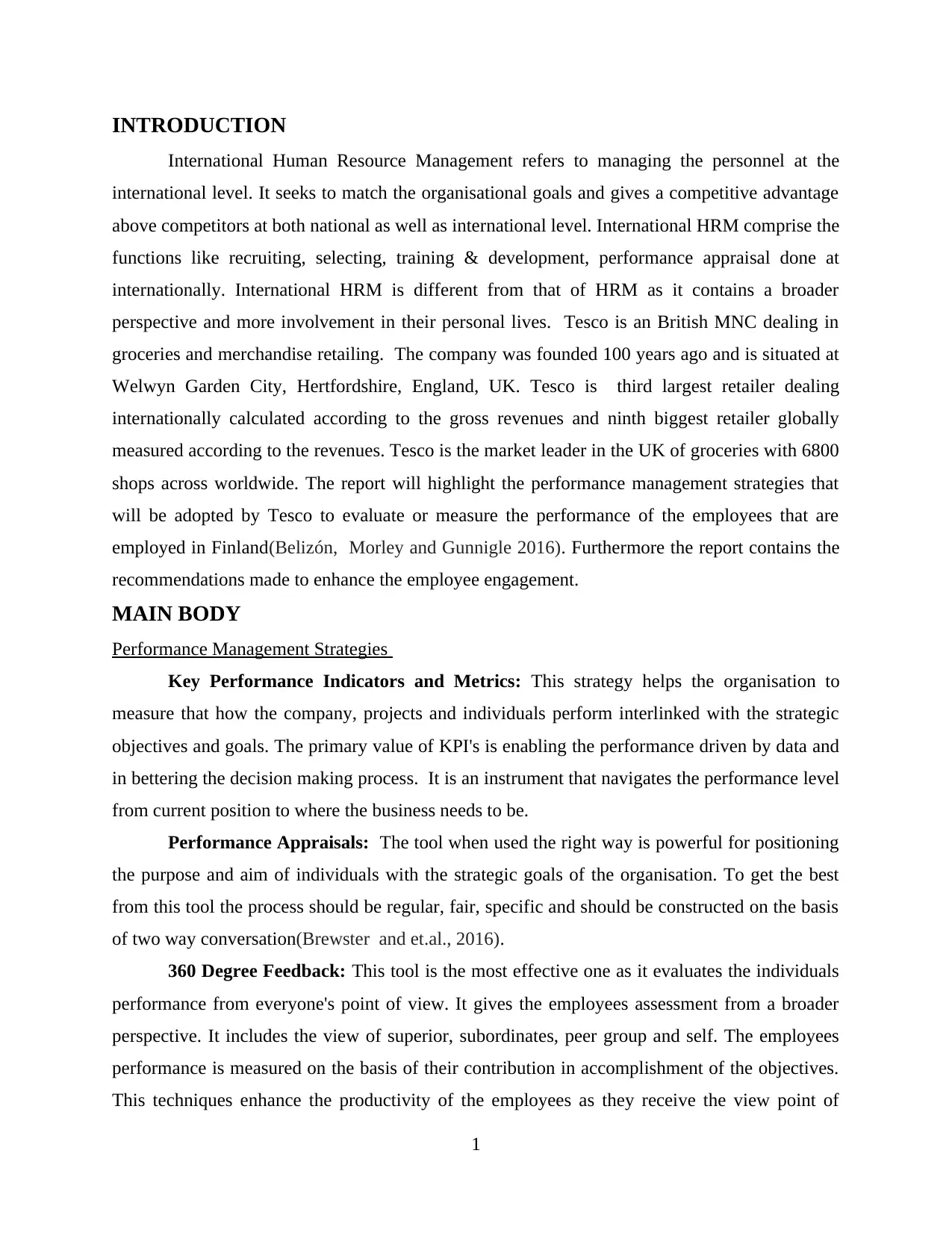
INTRODUCTION
International Human Resource Management refers to managing the personnel at the
international level. It seeks to match the organisational goals and gives a competitive advantage
above competitors at both national as well as international level. International HRM comprise the
functions like recruiting, selecting, training & development, performance appraisal done at
internationally. International HRM is different from that of HRM as it contains a broader
perspective and more involvement in their personal lives. Tesco is an British MNC dealing in
groceries and merchandise retailing. The company was founded 100 years ago and is situated at
Welwyn Garden City, Hertfordshire, England, UK. Tesco is third largest retailer dealing
internationally calculated according to the gross revenues and ninth biggest retailer globally
measured according to the revenues. Tesco is the market leader in the UK of groceries with 6800
shops across worldwide. The report will highlight the performance management strategies that
will be adopted by Tesco to evaluate or measure the performance of the employees that are
employed in Finland(Belizón, Morley and Gunnigle 2016). Furthermore the report contains the
recommendations made to enhance the employee engagement.
MAIN BODY
Performance Management Strategies
Key Performance Indicators and Metrics: This strategy helps the organisation to
measure that how the company, projects and individuals perform interlinked with the strategic
objectives and goals. The primary value of KPI's is enabling the performance driven by data and
in bettering the decision making process. It is an instrument that navigates the performance level
from current position to where the business needs to be.
Performance Appraisals: The tool when used the right way is powerful for positioning
the purpose and aim of individuals with the strategic goals of the organisation. To get the best
from this tool the process should be regular, fair, specific and should be constructed on the basis
of two way conversation(Brewster and et.al., 2016).
360 Degree Feedback: This tool is the most effective one as it evaluates the individuals
performance from everyone's point of view. It gives the employees assessment from a broader
perspective. It includes the view of superior, subordinates, peer group and self. The employees
performance is measured on the basis of their contribution in accomplishment of the objectives.
This techniques enhance the productivity of the employees as they receive the view point of
1
International Human Resource Management refers to managing the personnel at the
international level. It seeks to match the organisational goals and gives a competitive advantage
above competitors at both national as well as international level. International HRM comprise the
functions like recruiting, selecting, training & development, performance appraisal done at
internationally. International HRM is different from that of HRM as it contains a broader
perspective and more involvement in their personal lives. Tesco is an British MNC dealing in
groceries and merchandise retailing. The company was founded 100 years ago and is situated at
Welwyn Garden City, Hertfordshire, England, UK. Tesco is third largest retailer dealing
internationally calculated according to the gross revenues and ninth biggest retailer globally
measured according to the revenues. Tesco is the market leader in the UK of groceries with 6800
shops across worldwide. The report will highlight the performance management strategies that
will be adopted by Tesco to evaluate or measure the performance of the employees that are
employed in Finland(Belizón, Morley and Gunnigle 2016). Furthermore the report contains the
recommendations made to enhance the employee engagement.
MAIN BODY
Performance Management Strategies
Key Performance Indicators and Metrics: This strategy helps the organisation to
measure that how the company, projects and individuals perform interlinked with the strategic
objectives and goals. The primary value of KPI's is enabling the performance driven by data and
in bettering the decision making process. It is an instrument that navigates the performance level
from current position to where the business needs to be.
Performance Appraisals: The tool when used the right way is powerful for positioning
the purpose and aim of individuals with the strategic goals of the organisation. To get the best
from this tool the process should be regular, fair, specific and should be constructed on the basis
of two way conversation(Brewster and et.al., 2016).
360 Degree Feedback: This tool is the most effective one as it evaluates the individuals
performance from everyone's point of view. It gives the employees assessment from a broader
perspective. It includes the view of superior, subordinates, peer group and self. The employees
performance is measured on the basis of their contribution in accomplishment of the objectives.
This techniques enhance the productivity of the employees as they receive the view point of
1
⊘ This is a preview!⊘
Do you want full access?
Subscribe today to unlock all pages.

Trusted by 1+ million students worldwide
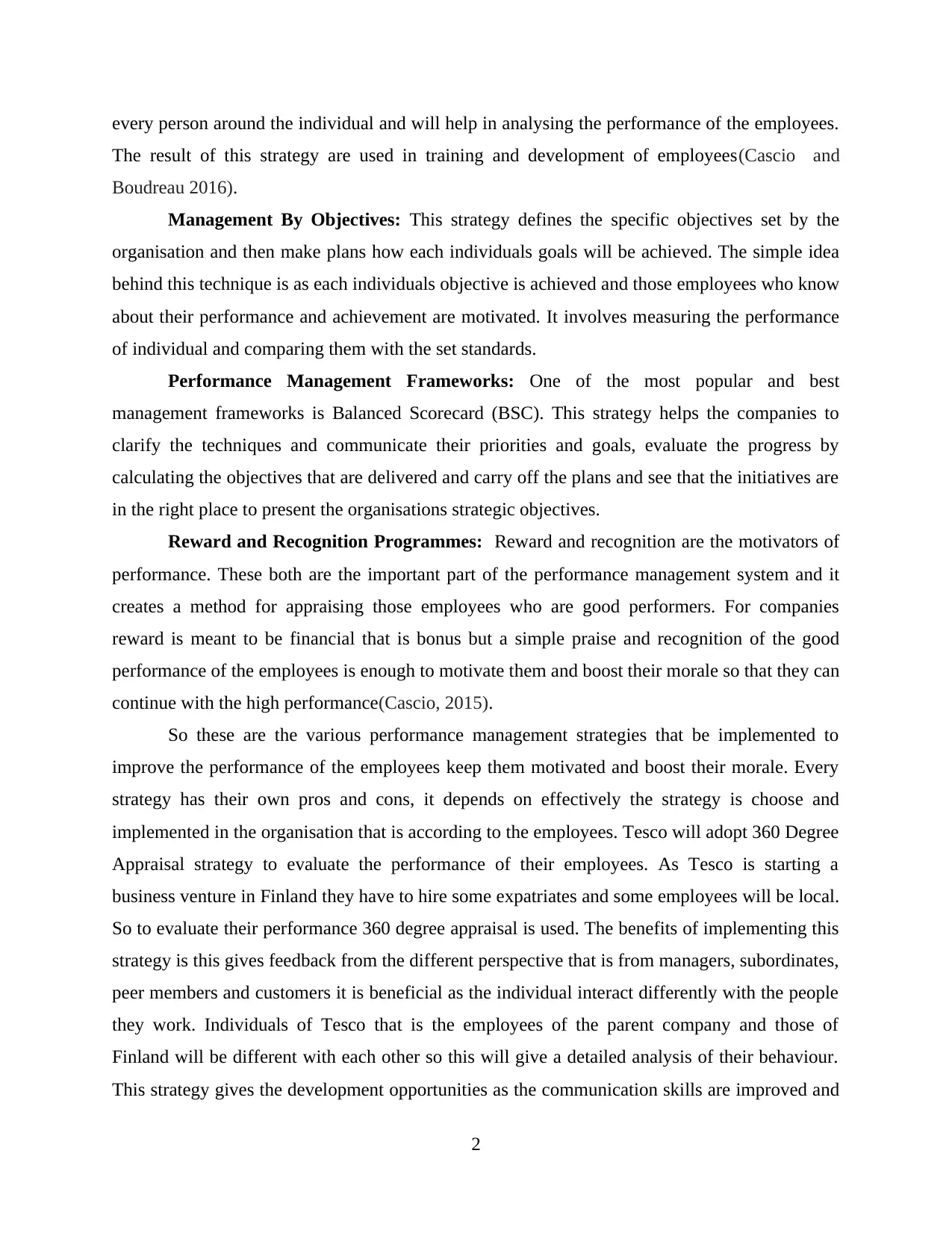
every person around the individual and will help in analysing the performance of the employees.
The result of this strategy are used in training and development of employees(Cascio and
Boudreau 2016).
Management By Objectives: This strategy defines the specific objectives set by the
organisation and then make plans how each individuals goals will be achieved. The simple idea
behind this technique is as each individuals objective is achieved and those employees who know
about their performance and achievement are motivated. It involves measuring the performance
of individual and comparing them with the set standards.
Performance Management Frameworks: One of the most popular and best
management frameworks is Balanced Scorecard (BSC). This strategy helps the companies to
clarify the techniques and communicate their priorities and goals, evaluate the progress by
calculating the objectives that are delivered and carry off the plans and see that the initiatives are
in the right place to present the organisations strategic objectives.
Reward and Recognition Programmes: Reward and recognition are the motivators of
performance. These both are the important part of the performance management system and it
creates a method for appraising those employees who are good performers. For companies
reward is meant to be financial that is bonus but a simple praise and recognition of the good
performance of the employees is enough to motivate them and boost their morale so that they can
continue with the high performance(Cascio, 2015).
So these are the various performance management strategies that be implemented to
improve the performance of the employees keep them motivated and boost their morale. Every
strategy has their own pros and cons, it depends on effectively the strategy is choose and
implemented in the organisation that is according to the employees. Tesco will adopt 360 Degree
Appraisal strategy to evaluate the performance of their employees. As Tesco is starting a
business venture in Finland they have to hire some expatriates and some employees will be local.
So to evaluate their performance 360 degree appraisal is used. The benefits of implementing this
strategy is this gives feedback from the different perspective that is from managers, subordinates,
peer members and customers it is beneficial as the individual interact differently with the people
they work. Individuals of Tesco that is the employees of the parent company and those of
Finland will be different with each other so this will give a detailed analysis of their behaviour.
This strategy gives the development opportunities as the communication skills are improved and
2
The result of this strategy are used in training and development of employees(Cascio and
Boudreau 2016).
Management By Objectives: This strategy defines the specific objectives set by the
organisation and then make plans how each individuals goals will be achieved. The simple idea
behind this technique is as each individuals objective is achieved and those employees who know
about their performance and achievement are motivated. It involves measuring the performance
of individual and comparing them with the set standards.
Performance Management Frameworks: One of the most popular and best
management frameworks is Balanced Scorecard (BSC). This strategy helps the companies to
clarify the techniques and communicate their priorities and goals, evaluate the progress by
calculating the objectives that are delivered and carry off the plans and see that the initiatives are
in the right place to present the organisations strategic objectives.
Reward and Recognition Programmes: Reward and recognition are the motivators of
performance. These both are the important part of the performance management system and it
creates a method for appraising those employees who are good performers. For companies
reward is meant to be financial that is bonus but a simple praise and recognition of the good
performance of the employees is enough to motivate them and boost their morale so that they can
continue with the high performance(Cascio, 2015).
So these are the various performance management strategies that be implemented to
improve the performance of the employees keep them motivated and boost their morale. Every
strategy has their own pros and cons, it depends on effectively the strategy is choose and
implemented in the organisation that is according to the employees. Tesco will adopt 360 Degree
Appraisal strategy to evaluate the performance of their employees. As Tesco is starting a
business venture in Finland they have to hire some expatriates and some employees will be local.
So to evaluate their performance 360 degree appraisal is used. The benefits of implementing this
strategy is this gives feedback from the different perspective that is from managers, subordinates,
peer members and customers it is beneficial as the individual interact differently with the people
they work. Individuals of Tesco that is the employees of the parent company and those of
Finland will be different with each other so this will give a detailed analysis of their behaviour.
This strategy gives the development opportunities as the communication skills are improved and
2
Paraphrase This Document
Need a fresh take? Get an instant paraphrase of this document with our AI Paraphraser
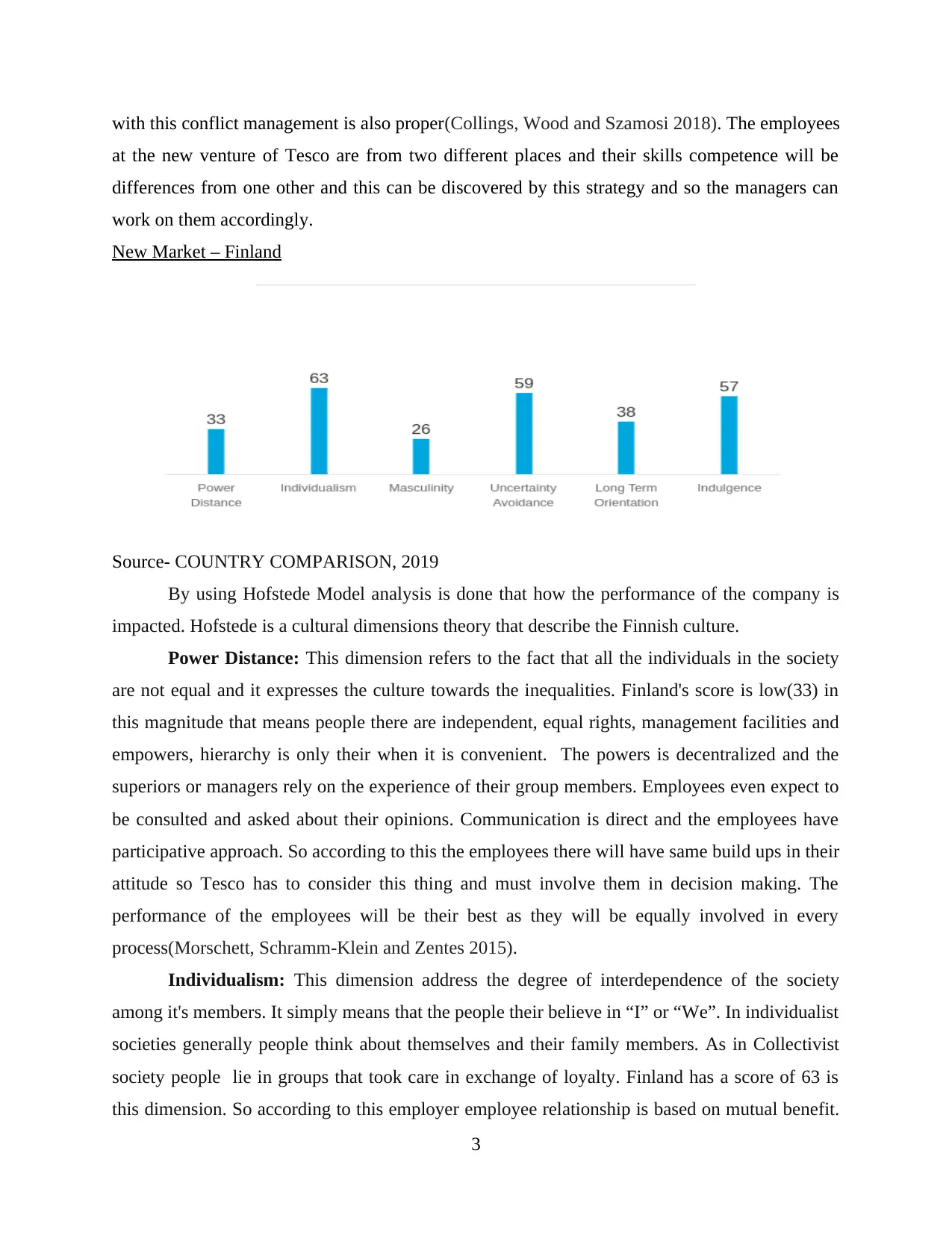
with this conflict management is also proper(Collings, Wood and Szamosi 2018). The employees
at the new venture of Tesco are from two different places and their skills competence will be
differences from one other and this can be discovered by this strategy and so the managers can
work on them accordingly.
New Market – Finland
Source- COUNTRY COMPARISON, 2019
By using Hofstede Model analysis is done that how the performance of the company is
impacted. Hofstede is a cultural dimensions theory that describe the Finnish culture.
Power Distance: This dimension refers to the fact that all the individuals in the society
are not equal and it expresses the culture towards the inequalities. Finland's score is low(33) in
this magnitude that means people there are independent, equal rights, management facilities and
empowers, hierarchy is only their when it is convenient. The powers is decentralized and the
superiors or managers rely on the experience of their group members. Employees even expect to
be consulted and asked about their opinions. Communication is direct and the employees have
participative approach. So according to this the employees there will have same build ups in their
attitude so Tesco has to consider this thing and must involve them in decision making. The
performance of the employees will be their best as they will be equally involved in every
process(Morschett, Schramm-Klein and Zentes 2015).
Individualism: This dimension address the degree of interdependence of the society
among it's members. It simply means that the people their believe in “I” or “We”. In individualist
societies generally people think about themselves and their family members. As in Collectivist
society people lie in groups that took care in exchange of loyalty. Finland has a score of 63 is
this dimension. So according to this employer employee relationship is based on mutual benefit.
3
at the new venture of Tesco are from two different places and their skills competence will be
differences from one other and this can be discovered by this strategy and so the managers can
work on them accordingly.
New Market – Finland
Source- COUNTRY COMPARISON, 2019
By using Hofstede Model analysis is done that how the performance of the company is
impacted. Hofstede is a cultural dimensions theory that describe the Finnish culture.
Power Distance: This dimension refers to the fact that all the individuals in the society
are not equal and it expresses the culture towards the inequalities. Finland's score is low(33) in
this magnitude that means people there are independent, equal rights, management facilities and
empowers, hierarchy is only their when it is convenient. The powers is decentralized and the
superiors or managers rely on the experience of their group members. Employees even expect to
be consulted and asked about their opinions. Communication is direct and the employees have
participative approach. So according to this the employees there will have same build ups in their
attitude so Tesco has to consider this thing and must involve them in decision making. The
performance of the employees will be their best as they will be equally involved in every
process(Morschett, Schramm-Klein and Zentes 2015).
Individualism: This dimension address the degree of interdependence of the society
among it's members. It simply means that the people their believe in “I” or “We”. In individualist
societies generally people think about themselves and their family members. As in Collectivist
society people lie in groups that took care in exchange of loyalty. Finland has a score of 63 is
this dimension. So according to this employer employee relationship is based on mutual benefit.
3
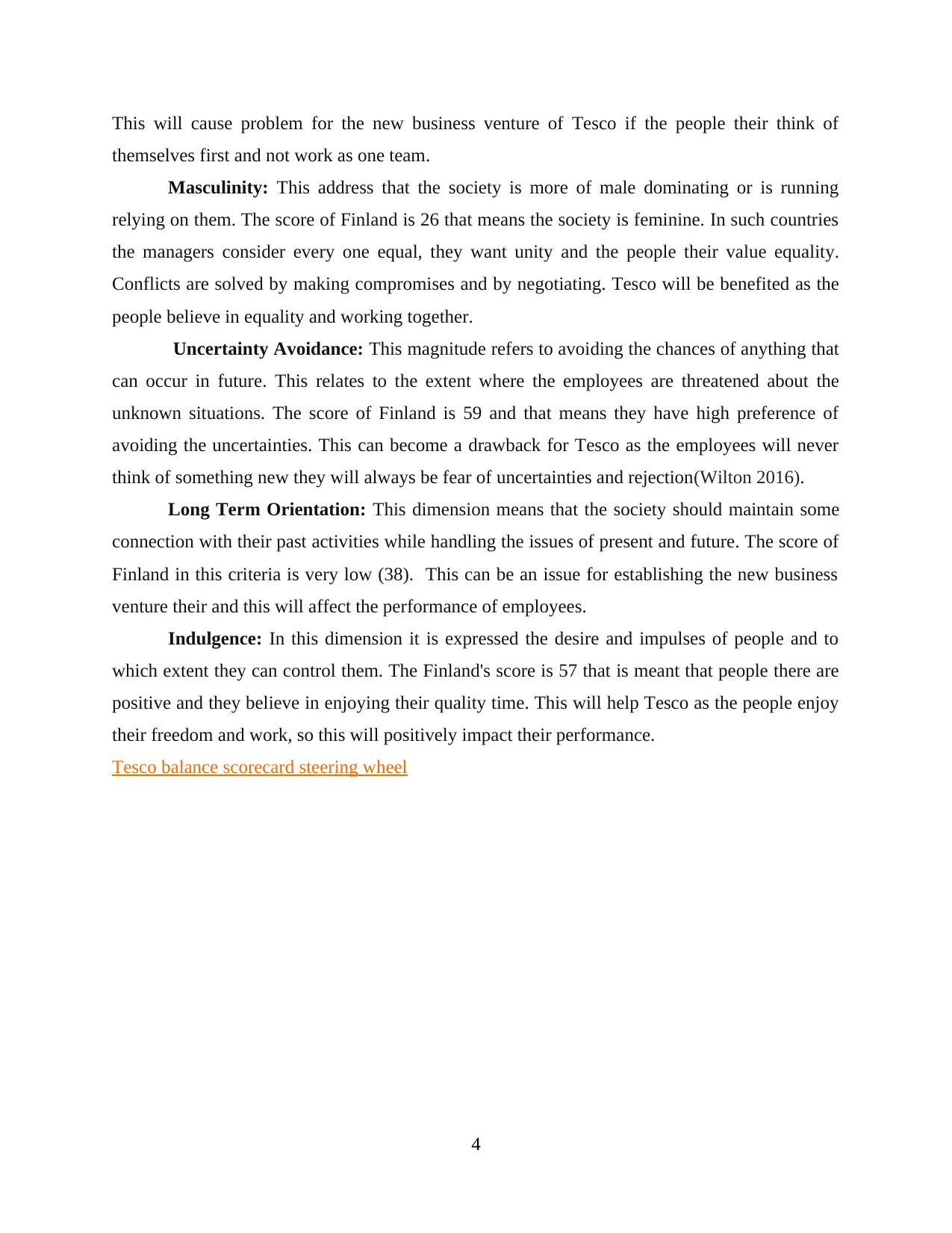
This will cause problem for the new business venture of Tesco if the people their think of
themselves first and not work as one team.
Masculinity: This address that the society is more of male dominating or is running
relying on them. The score of Finland is 26 that means the society is feminine. In such countries
the managers consider every one equal, they want unity and the people their value equality.
Conflicts are solved by making compromises and by negotiating. Tesco will be benefited as the
people believe in equality and working together.
Uncertainty Avoidance: This magnitude refers to avoiding the chances of anything that
can occur in future. This relates to the extent where the employees are threatened about the
unknown situations. The score of Finland is 59 and that means they have high preference of
avoiding the uncertainties. This can become a drawback for Tesco as the employees will never
think of something new they will always be fear of uncertainties and rejection(Wilton 2016).
Long Term Orientation: This dimension means that the society should maintain some
connection with their past activities while handling the issues of present and future. The score of
Finland in this criteria is very low (38). This can be an issue for establishing the new business
venture their and this will affect the performance of employees.
Indulgence: In this dimension it is expressed the desire and impulses of people and to
which extent they can control them. The Finland's score is 57 that is meant that people there are
positive and they believe in enjoying their quality time. This will help Tesco as the people enjoy
their freedom and work, so this will positively impact their performance.
Tesco balance scorecard steering wheel
4
themselves first and not work as one team.
Masculinity: This address that the society is more of male dominating or is running
relying on them. The score of Finland is 26 that means the society is feminine. In such countries
the managers consider every one equal, they want unity and the people their value equality.
Conflicts are solved by making compromises and by negotiating. Tesco will be benefited as the
people believe in equality and working together.
Uncertainty Avoidance: This magnitude refers to avoiding the chances of anything that
can occur in future. This relates to the extent where the employees are threatened about the
unknown situations. The score of Finland is 59 and that means they have high preference of
avoiding the uncertainties. This can become a drawback for Tesco as the employees will never
think of something new they will always be fear of uncertainties and rejection(Wilton 2016).
Long Term Orientation: This dimension means that the society should maintain some
connection with their past activities while handling the issues of present and future. The score of
Finland in this criteria is very low (38). This can be an issue for establishing the new business
venture their and this will affect the performance of employees.
Indulgence: In this dimension it is expressed the desire and impulses of people and to
which extent they can control them. The Finland's score is 57 that is meant that people there are
positive and they believe in enjoying their quality time. This will help Tesco as the people enjoy
their freedom and work, so this will positively impact their performance.
Tesco balance scorecard steering wheel
4
⊘ This is a preview!⊘
Do you want full access?
Subscribe today to unlock all pages.

Trusted by 1+ million students worldwide
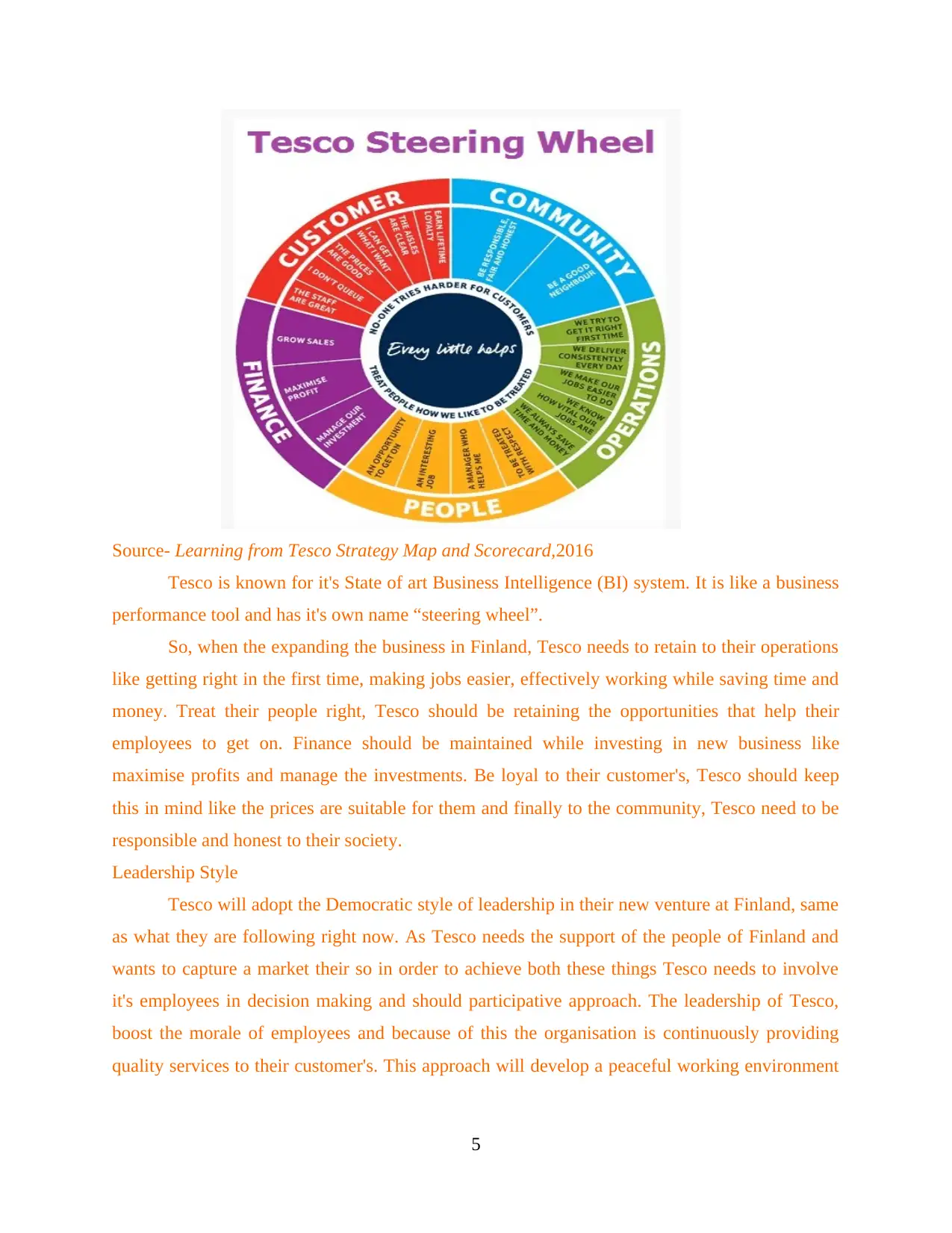
Source- Learning from Tesco Strategy Map and Scorecard,2016
Tesco is known for it's State of art Business Intelligence (BI) system. It is like a business
performance tool and has it's own name “steering wheel”.
So, when the expanding the business in Finland, Tesco needs to retain to their operations
like getting right in the first time, making jobs easier, effectively working while saving time and
money. Treat their people right, Tesco should be retaining the opportunities that help their
employees to get on. Finance should be maintained while investing in new business like
maximise profits and manage the investments. Be loyal to their customer's, Tesco should keep
this in mind like the prices are suitable for them and finally to the community, Tesco need to be
responsible and honest to their society.
Leadership Style
Tesco will adopt the Democratic style of leadership in their new venture at Finland, same
as what they are following right now. As Tesco needs the support of the people of Finland and
wants to capture a market their so in order to achieve both these things Tesco needs to involve
it's employees in decision making and should participative approach. The leadership of Tesco,
boost the morale of employees and because of this the organisation is continuously providing
quality services to their customer's. This approach will develop a peaceful working environment
5
Tesco is known for it's State of art Business Intelligence (BI) system. It is like a business
performance tool and has it's own name “steering wheel”.
So, when the expanding the business in Finland, Tesco needs to retain to their operations
like getting right in the first time, making jobs easier, effectively working while saving time and
money. Treat their people right, Tesco should be retaining the opportunities that help their
employees to get on. Finance should be maintained while investing in new business like
maximise profits and manage the investments. Be loyal to their customer's, Tesco should keep
this in mind like the prices are suitable for them and finally to the community, Tesco need to be
responsible and honest to their society.
Leadership Style
Tesco will adopt the Democratic style of leadership in their new venture at Finland, same
as what they are following right now. As Tesco needs the support of the people of Finland and
wants to capture a market their so in order to achieve both these things Tesco needs to involve
it's employees in decision making and should participative approach. The leadership of Tesco,
boost the morale of employees and because of this the organisation is continuously providing
quality services to their customer's. This approach will develop a peaceful working environment
5
Paraphrase This Document
Need a fresh take? Get an instant paraphrase of this document with our AI Paraphraser
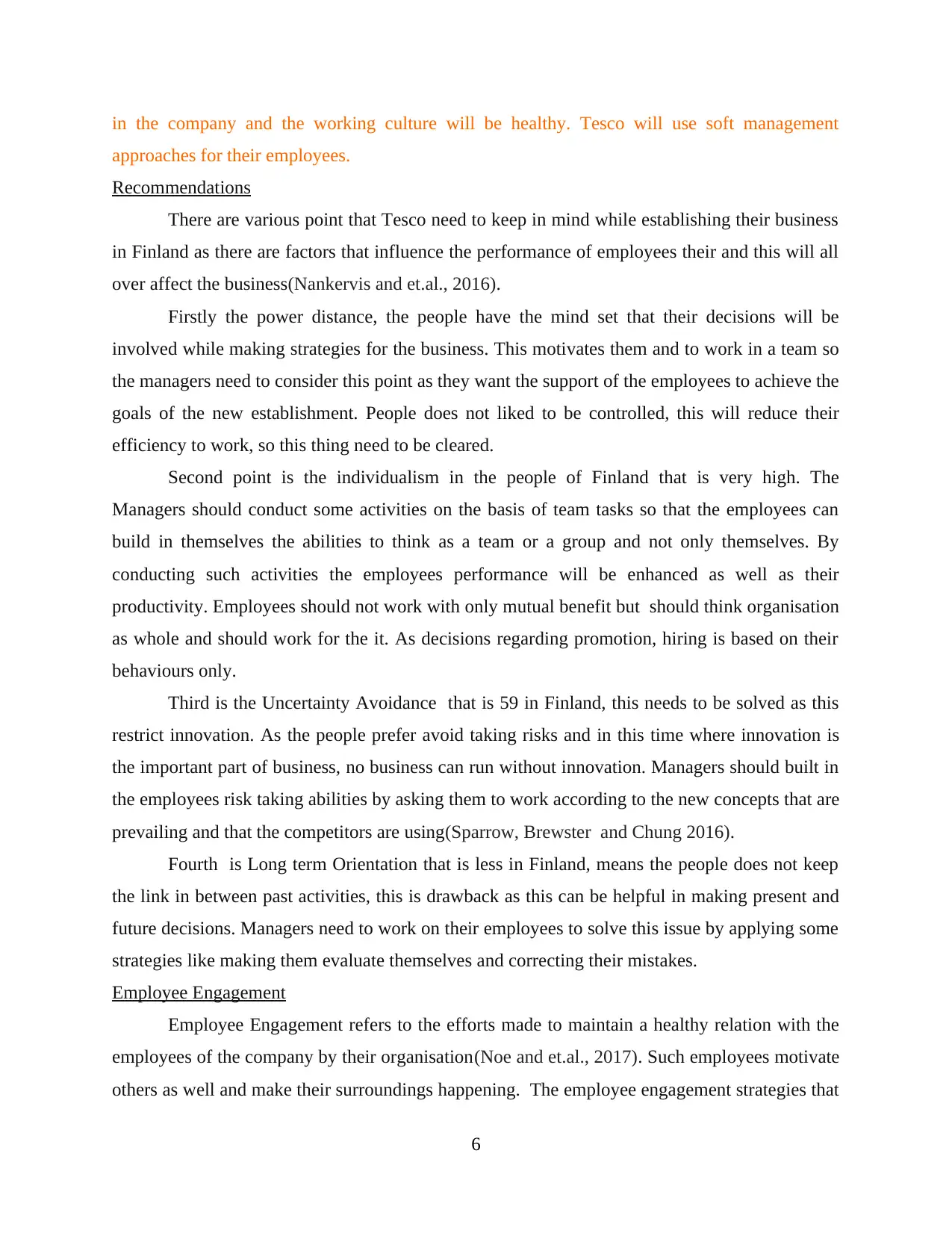
in the company and the working culture will be healthy. Tesco will use soft management
approaches for their employees.
Recommendations
There are various point that Tesco need to keep in mind while establishing their business
in Finland as there are factors that influence the performance of employees their and this will all
over affect the business(Nankervis and et.al., 2016).
Firstly the power distance, the people have the mind set that their decisions will be
involved while making strategies for the business. This motivates them and to work in a team so
the managers need to consider this point as they want the support of the employees to achieve the
goals of the new establishment. People does not liked to be controlled, this will reduce their
efficiency to work, so this thing need to be cleared.
Second point is the individualism in the people of Finland that is very high. The
Managers should conduct some activities on the basis of team tasks so that the employees can
build in themselves the abilities to think as a team or a group and not only themselves. By
conducting such activities the employees performance will be enhanced as well as their
productivity. Employees should not work with only mutual benefit but should think organisation
as whole and should work for the it. As decisions regarding promotion, hiring is based on their
behaviours only.
Third is the Uncertainty Avoidance that is 59 in Finland, this needs to be solved as this
restrict innovation. As the people prefer avoid taking risks and in this time where innovation is
the important part of business, no business can run without innovation. Managers should built in
the employees risk taking abilities by asking them to work according to the new concepts that are
prevailing and that the competitors are using(Sparrow, Brewster and Chung 2016).
Fourth is Long term Orientation that is less in Finland, means the people does not keep
the link in between past activities, this is drawback as this can be helpful in making present and
future decisions. Managers need to work on their employees to solve this issue by applying some
strategies like making them evaluate themselves and correcting their mistakes.
Employee Engagement
Employee Engagement refers to the efforts made to maintain a healthy relation with the
employees of the company by their organisation(Noe and et.al., 2017). Such employees motivate
others as well and make their surroundings happening. The employee engagement strategies that
6
approaches for their employees.
Recommendations
There are various point that Tesco need to keep in mind while establishing their business
in Finland as there are factors that influence the performance of employees their and this will all
over affect the business(Nankervis and et.al., 2016).
Firstly the power distance, the people have the mind set that their decisions will be
involved while making strategies for the business. This motivates them and to work in a team so
the managers need to consider this point as they want the support of the employees to achieve the
goals of the new establishment. People does not liked to be controlled, this will reduce their
efficiency to work, so this thing need to be cleared.
Second point is the individualism in the people of Finland that is very high. The
Managers should conduct some activities on the basis of team tasks so that the employees can
build in themselves the abilities to think as a team or a group and not only themselves. By
conducting such activities the employees performance will be enhanced as well as their
productivity. Employees should not work with only mutual benefit but should think organisation
as whole and should work for the it. As decisions regarding promotion, hiring is based on their
behaviours only.
Third is the Uncertainty Avoidance that is 59 in Finland, this needs to be solved as this
restrict innovation. As the people prefer avoid taking risks and in this time where innovation is
the important part of business, no business can run without innovation. Managers should built in
the employees risk taking abilities by asking them to work according to the new concepts that are
prevailing and that the competitors are using(Sparrow, Brewster and Chung 2016).
Fourth is Long term Orientation that is less in Finland, means the people does not keep
the link in between past activities, this is drawback as this can be helpful in making present and
future decisions. Managers need to work on their employees to solve this issue by applying some
strategies like making them evaluate themselves and correcting their mistakes.
Employee Engagement
Employee Engagement refers to the efforts made to maintain a healthy relation with the
employees of the company by their organisation(Noe and et.al., 2017). Such employees motivate
others as well and make their surroundings happening. The employee engagement strategies that
6
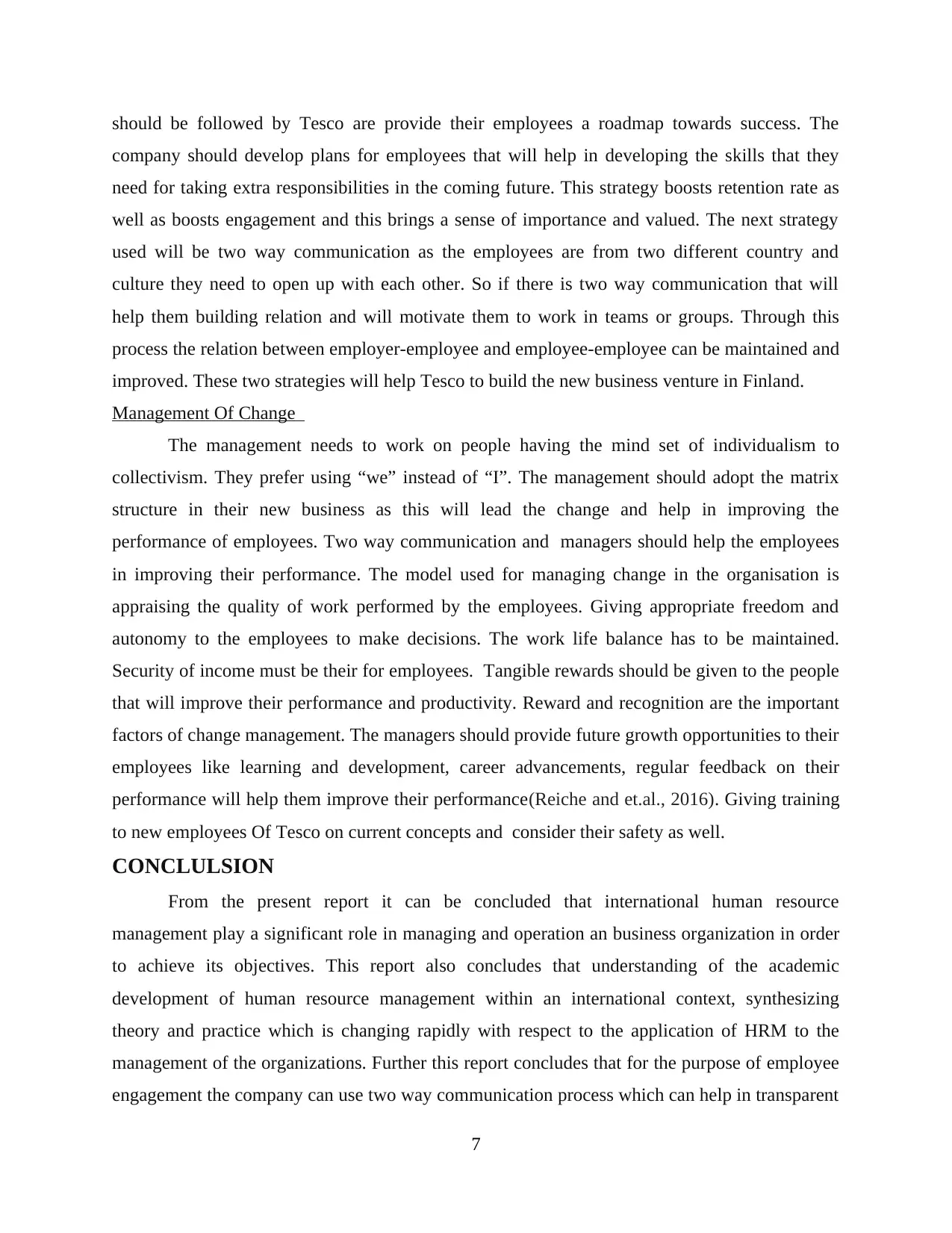
should be followed by Tesco are provide their employees a roadmap towards success. The
company should develop plans for employees that will help in developing the skills that they
need for taking extra responsibilities in the coming future. This strategy boosts retention rate as
well as boosts engagement and this brings a sense of importance and valued. The next strategy
used will be two way communication as the employees are from two different country and
culture they need to open up with each other. So if there is two way communication that will
help them building relation and will motivate them to work in teams or groups. Through this
process the relation between employer-employee and employee-employee can be maintained and
improved. These two strategies will help Tesco to build the new business venture in Finland.
Management Of Change
The management needs to work on people having the mind set of individualism to
collectivism. They prefer using “we” instead of “I”. The management should adopt the matrix
structure in their new business as this will lead the change and help in improving the
performance of employees. Two way communication and managers should help the employees
in improving their performance. The model used for managing change in the organisation is
appraising the quality of work performed by the employees. Giving appropriate freedom and
autonomy to the employees to make decisions. The work life balance has to be maintained.
Security of income must be their for employees. Tangible rewards should be given to the people
that will improve their performance and productivity. Reward and recognition are the important
factors of change management. The managers should provide future growth opportunities to their
employees like learning and development, career advancements, regular feedback on their
performance will help them improve their performance(Reiche and et.al., 2016). Giving training
to new employees Of Tesco on current concepts and consider their safety as well.
CONCLULSION
From the present report it can be concluded that international human resource
management play a significant role in managing and operation an business organization in order
to achieve its objectives. This report also concludes that understanding of the academic
development of human resource management within an international context, synthesizing
theory and practice which is changing rapidly with respect to the application of HRM to the
management of the organizations. Further this report concludes that for the purpose of employee
engagement the company can use two way communication process which can help in transparent
7
company should develop plans for employees that will help in developing the skills that they
need for taking extra responsibilities in the coming future. This strategy boosts retention rate as
well as boosts engagement and this brings a sense of importance and valued. The next strategy
used will be two way communication as the employees are from two different country and
culture they need to open up with each other. So if there is two way communication that will
help them building relation and will motivate them to work in teams or groups. Through this
process the relation between employer-employee and employee-employee can be maintained and
improved. These two strategies will help Tesco to build the new business venture in Finland.
Management Of Change
The management needs to work on people having the mind set of individualism to
collectivism. They prefer using “we” instead of “I”. The management should adopt the matrix
structure in their new business as this will lead the change and help in improving the
performance of employees. Two way communication and managers should help the employees
in improving their performance. The model used for managing change in the organisation is
appraising the quality of work performed by the employees. Giving appropriate freedom and
autonomy to the employees to make decisions. The work life balance has to be maintained.
Security of income must be their for employees. Tangible rewards should be given to the people
that will improve their performance and productivity. Reward and recognition are the important
factors of change management. The managers should provide future growth opportunities to their
employees like learning and development, career advancements, regular feedback on their
performance will help them improve their performance(Reiche and et.al., 2016). Giving training
to new employees Of Tesco on current concepts and consider their safety as well.
CONCLULSION
From the present report it can be concluded that international human resource
management play a significant role in managing and operation an business organization in order
to achieve its objectives. This report also concludes that understanding of the academic
development of human resource management within an international context, synthesizing
theory and practice which is changing rapidly with respect to the application of HRM to the
management of the organizations. Further this report concludes that for the purpose of employee
engagement the company can use two way communication process which can help in transparent
7
⊘ This is a preview!⊘
Do you want full access?
Subscribe today to unlock all pages.

Trusted by 1+ million students worldwide

decision making and team building. Lastly this report contains evaluation of a range of
international HRM practices and procedures on the impact of change management.
8
international HRM practices and procedures on the impact of change management.
8
Paraphrase This Document
Need a fresh take? Get an instant paraphrase of this document with our AI Paraphraser
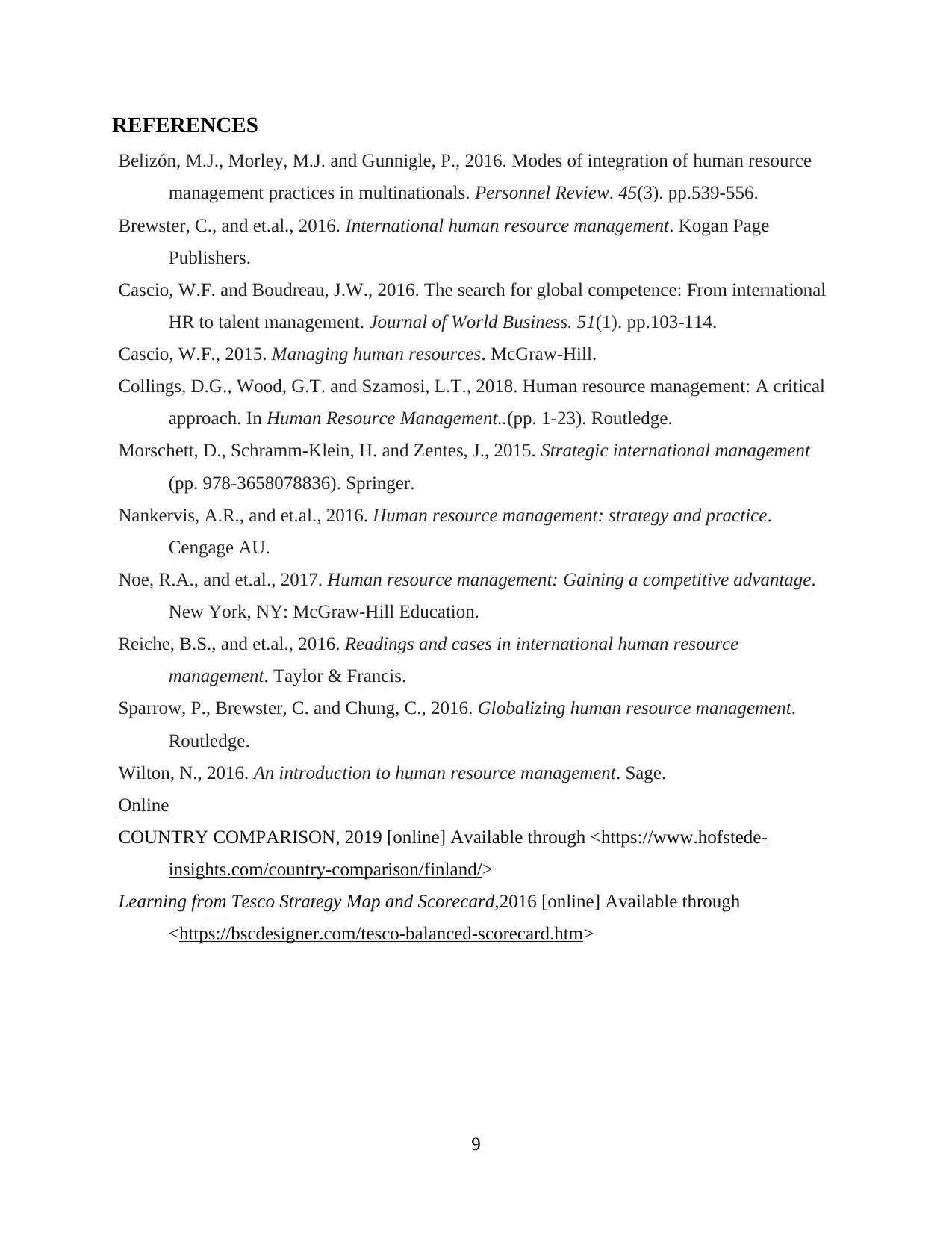
REFERENCES
Belizón, M.J., Morley, M.J. and Gunnigle, P., 2016. Modes of integration of human resource
management practices in multinationals. Personnel Review. 45(3). pp.539-556.
Brewster, C., and et.al., 2016. International human resource management. Kogan Page
Publishers.
Cascio, W.F. and Boudreau, J.W., 2016. The search for global competence: From international
HR to talent management. Journal of World Business. 51(1). pp.103-114.
Cascio, W.F., 2015. Managing human resources. McGraw-Hill.
Collings, D.G., Wood, G.T. and Szamosi, L.T., 2018. Human resource management: A critical
approach. In Human Resource Management..(pp. 1-23). Routledge.
Morschett, D., Schramm-Klein, H. and Zentes, J., 2015. Strategic international management
(pp. 978-3658078836). Springer.
Nankervis, A.R., and et.al., 2016. Human resource management: strategy and practice.
Cengage AU.
Noe, R.A., and et.al., 2017. Human resource management: Gaining a competitive advantage.
New York, NY: McGraw-Hill Education.
Reiche, B.S., and et.al., 2016. Readings and cases in international human resource
management. Taylor & Francis.
Sparrow, P., Brewster, C. and Chung, C., 2016. Globalizing human resource management.
Routledge.
Wilton, N., 2016. An introduction to human resource management. Sage.
Online
COUNTRY COMPARISON, 2019 [online] Available through <https://www.hofstede-
insights.com/country-comparison/finland/>
Learning from Tesco Strategy Map and Scorecard,2016 [online] Available through
<https://bscdesigner.com/tesco-balanced-scorecard.htm>
9
Belizón, M.J., Morley, M.J. and Gunnigle, P., 2016. Modes of integration of human resource
management practices in multinationals. Personnel Review. 45(3). pp.539-556.
Brewster, C., and et.al., 2016. International human resource management. Kogan Page
Publishers.
Cascio, W.F. and Boudreau, J.W., 2016. The search for global competence: From international
HR to talent management. Journal of World Business. 51(1). pp.103-114.
Cascio, W.F., 2015. Managing human resources. McGraw-Hill.
Collings, D.G., Wood, G.T. and Szamosi, L.T., 2018. Human resource management: A critical
approach. In Human Resource Management..(pp. 1-23). Routledge.
Morschett, D., Schramm-Klein, H. and Zentes, J., 2015. Strategic international management
(pp. 978-3658078836). Springer.
Nankervis, A.R., and et.al., 2016. Human resource management: strategy and practice.
Cengage AU.
Noe, R.A., and et.al., 2017. Human resource management: Gaining a competitive advantage.
New York, NY: McGraw-Hill Education.
Reiche, B.S., and et.al., 2016. Readings and cases in international human resource
management. Taylor & Francis.
Sparrow, P., Brewster, C. and Chung, C., 2016. Globalizing human resource management.
Routledge.
Wilton, N., 2016. An introduction to human resource management. Sage.
Online
COUNTRY COMPARISON, 2019 [online] Available through <https://www.hofstede-
insights.com/country-comparison/finland/>
Learning from Tesco Strategy Map and Scorecard,2016 [online] Available through
<https://bscdesigner.com/tesco-balanced-scorecard.htm>
9
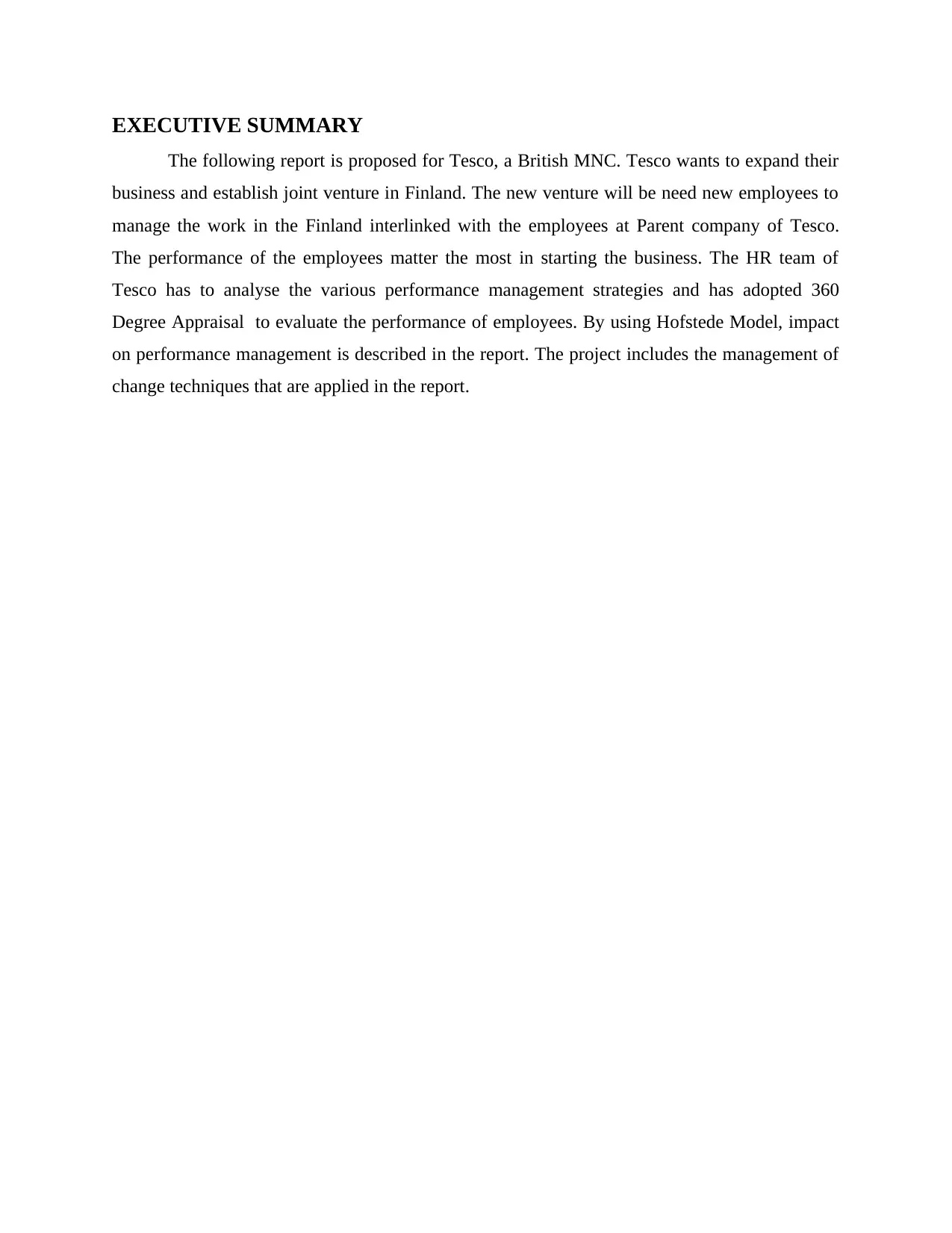
EXECUTIVE SUMMARY
The following report is proposed for Tesco, a British MNC. Tesco wants to expand their
business and establish joint venture in Finland. The new venture will be need new employees to
manage the work in the Finland interlinked with the employees at Parent company of Tesco.
The performance of the employees matter the most in starting the business. The HR team of
Tesco has to analyse the various performance management strategies and has adopted 360
Degree Appraisal to evaluate the performance of employees. By using Hofstede Model, impact
on performance management is described in the report. The project includes the management of
change techniques that are applied in the report.
The following report is proposed for Tesco, a British MNC. Tesco wants to expand their
business and establish joint venture in Finland. The new venture will be need new employees to
manage the work in the Finland interlinked with the employees at Parent company of Tesco.
The performance of the employees matter the most in starting the business. The HR team of
Tesco has to analyse the various performance management strategies and has adopted 360
Degree Appraisal to evaluate the performance of employees. By using Hofstede Model, impact
on performance management is described in the report. The project includes the management of
change techniques that are applied in the report.
⊘ This is a preview!⊘
Do you want full access?
Subscribe today to unlock all pages.

Trusted by 1+ million students worldwide
1 out of 12
Related Documents
Your All-in-One AI-Powered Toolkit for Academic Success.
+13062052269
info@desklib.com
Available 24*7 on WhatsApp / Email
![[object Object]](/_next/static/media/star-bottom.7253800d.svg)
Unlock your academic potential
Copyright © 2020–2025 A2Z Services. All Rights Reserved. Developed and managed by ZUCOL.





